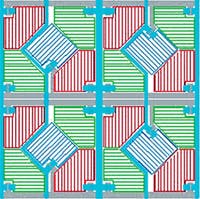Traditional liquid-crystal displays (LCDs) use spatial color filters to produce color images that divide each pixel into red, green, and blue subpixels. These filters are aligned vertically to assign a constant color to each column of pixels and allow the LCD panel to be interfaced in a way similar to cathode-ray tubes (CRTs). These columns or stripes may have different widths to provide color balance by adjusting the area of each color. Three subpixels, one each of red, green, and blue (RGB), combine to form a logical pixel.
To lower cost, LCDs can be fabricated with three-color pixels instead of subpixels. This method uses one-third the number of column drivers than the RGB stripe arrangement. But since the same column driver turns on different colors at different locations and times, the three-color or triad system requires slightly higher overhead to multiplex the color signals. One advantage of triad designs over RGB subpixel stripe implementations is that less area is lost to spaces between subpixels, which leads to higher fill factors and increased brightness.
Sharing the color triad arrangement's reduced cost and increased brightness from reduced loss to borders, the PenTile Matrix (PenTile Matrix Licensing; Vallejo, CA) is a new display technology that promises to double the addressable resolution in each axis, while providing antialiasing of displayed images (see figure). Already licensed by MicroDisplay Corp. (San Pablo, CA), the technology uses a checkerboard pattern of alternating red and green pixels while reducing the blue information by half compared to the red and green pixels.
To attain its high resolution, the new matrix-display technology uses the company's ClairVoyante subpixel rendering algorithm. During operation, each logical pixel assigns a weighted mapping of the conventional software logical pixel's three color values (R, G, and B), with the color subpixels on the display.
To display a single bright white dot centered on the green subpixel, for example, the green subpixel is set to 50%, the four surrounding red subpixels are set to 12.5%, and the blue subpixel is set to 25%. Consequently, the energy of the original white dot is spread over these subpixels in a Gaussian spot, much like that displayed by a CRT.
Whereas logical pixels are displayed next to each other, the values of the overlapping logical subpixels are added together. Therefore, if a given area of the display is white, the values for all of the subpixels add up to 100%. The value of any given subpixel is then half of the input value of the original software logical pixel at that location, with the remaining energy coming from the surrounding four software logical pixels.





